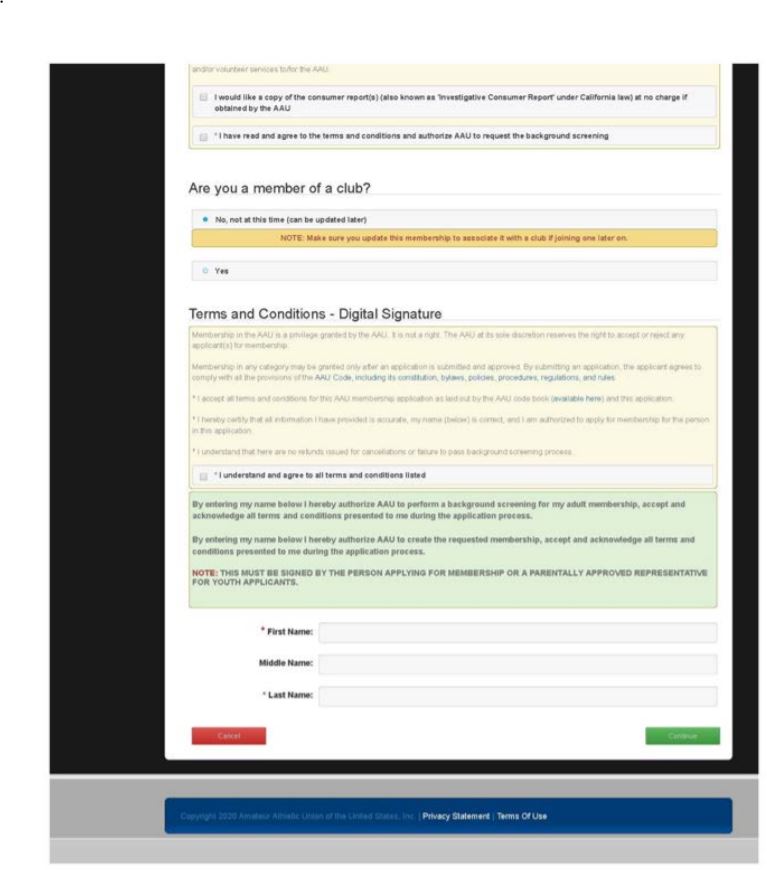Court Upholds Formation of a Lengthy Contract Presented on a Mobile Device–Hidalgo v. AAU
The plaintiffs are suing over a data breach. The defendant sought to invoke its arbitration clause in its membership agreement. The court finds the contract formed and sends the case to arbitration.
The case involves the following screenshot as part of the membership application:
The green button says “Continue.” Before prospective members can proceed, they must check the mandatory box (in white above the green field) saying “I understand and agree to all terms and conditions listed.” The yellow field says: “By submitting an application, the applicant agrees to comply with the provisions of the AAU Code, including its constitution, bylaws, policies, procedures, regulations, and rules.” Each of those referenced documents is hyperlinked. The yellow field also contains the statement: “I accept all terms and conditions for this AAU membership application as laid out by the AAU code book (available here) and this application.”
Each link to the code book goes to a table of contents page, where prospective members can access a PDF of the entire code book or follow further hyperlinks to each component of the code book. Eventually, if they navigate correctly, the prospective members will see the arbitration agreement.
The court says Hidalgo had reasonable notice of the terms. The court favorably cites the following design choices:
- the page is “relatively uncluttered.” This includes the bolding, yellow shading, and blue hyperlinks. “The relevant text in the ‘terms and conditions’ box on the AAU application screen clearly draws a reasonable user’s attention to it because of the blue hyperlinks, the red asterisks, the normal font size, and the clear contrast between the mostly black text and the yellow background.”
- even though the application was lengthy, prospective members had to pass through the T&C section to complete the process.
- the court calls this a “clickwrap” because of the two-click process (click on the T&Cs, then the “continue” button). The call-to-action was appropriately worded.
- the T&Cs were “spatially and temporally coupled” with the application submission.
I think the court is being generous calling this a “relatively uncluttered” page. It has a lot going on. Still, a mandatory two-click process can overcome a lot of other problems. All told, this is a strong contract formation process, and it’s not surprising that the court blessed it.
Nevertheless, Hidalgo applied for membership on his iPhone using the Safari browser, and apparently the application wasn’t optimized for mobile devices. As a result, “the plaintiff complains that he ‘had to move the screen back and forth for each line of text’ and zoom in and out because the full application was not visible on the iPhone screen at one time.” The argument falls flat because, despite the navigation challenges, Hidalgo actually remembered going through the contract formation process. Also, he checked the mandatory checkbox. The court adds:
The plaintiff points to no authority for the proposition that a reasonably prudent smartphone user does not have inquiry notice of terms and conditions when the user physically checks a box indicating that the user understands and agrees to the terms and conditions. Moreover, the plaintiff fails to articulate why a “reasonably prudent smartphone user” would not have reasonable notice of the hyperlinks on the AAU application page simply because the smartphone user had to scroll around and zoom in and out on certain text on the smartphone screen to complete the application.
Hidalgo also complained that the code book was 170 pages, so he shouldn’t have to wade through that behemoth to find the arbitration clause. The court shows no sympathy for this argument. Among other reasons, the court explains that applicants could navigate the table of contents to find the header named “binding arbitration.” That’s a bit of a cheat because now we know that arbitration is the clause he needed to review. That wasn’t clear at formation time. Instead, Hidalgo was confronted with 170 pages of legalese that could have contained god-knows-what. I doubt any of us would have fully reviewed all 170 pages prospectively, just-in-case.
While AAU got the contract formation result it wanted (mandatory two-click processes FTW!), it could have done an even better job by optimizing the page for mobile devices. You should ALWAYS double-check your contract formation on multiple devices and operating systems to ensure that everything works properly in all of the different interfaces.
Case citation: Hidalgo v. Amateur Athletic Union of the US, Inc., 2020 WL 3264174 (SDNY June 16, 2020). For reasons that are unclear to me, the opinion came through Westlaw a second time at 2020 WL 3442029 with a claimed signing date of June 24, 2020.

Pingback: News of the Week; July 1, 2020 – Communications Law at Allard Hall()